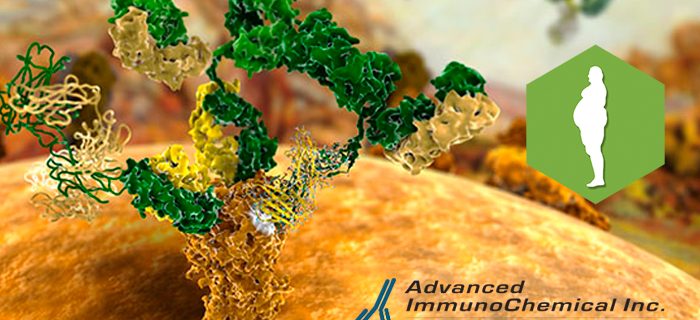Retinol-binding protein (RBP4) TechNotes
Open full PDF AssayNotes for RBP4.
New. Advanced ImmunoChemical offers a set of mouse monoclonal anti-human RBP4 antibodies suitable for development of sandwich immunoassays for quantitative detection of circulating RBP4 in human plasma as well as for immunodetection of RBP4 in: direct ELISA, Western blotting, or to for immunoprecipitation of the antigen.
Retinol-binding protein (RBP4) belongs to a lipocalin protein family and functions as a carrier protein for vitamin A in serum. Human retinol-binding protein circulating in blood consists of 183 amino acid residues. Several truncated isoforms of RBP4 lacking 1, 2, 4 or 6 of the very C-terminal residues were also described in literature. In blood RBP4 carries retinol (vitamin A) which is bound to RBP4 in equimolar ratio. Besides, major part of circulating RBP4 forms complex with prealbumin (transthyretin) and only small fraction of free RBP4 can be found in serum.
RBP4 has been studied since 1960s mainly as a transporter of retinol, but recent data suggest that RBP4 may contribute to pathogenesis of type 2 diabetes (1). It has been demonstrated that serum RBP4 levels are elevated in patients with obesity and type 2 diabetes (2). Studies in mice showed that serum RBP4 may cause insulin resistance. So, on the one hand, there is growing body of evidence demonstrating that RBP4 is a promising marker of the risk of type 2 diabetes, but on the other hand there is conflicting situation in the literature regarding RBP4 clinical utility in predicting insulin resistance and type 2 diabetes (3). Some authors show strict correlation between circulating RBP4 and magnitude of insulin resistance in subjects with obesity and type 2 diabetes and non-obese subjects with family history of type 2 diabetes. On the contrary, others had not found any correlation between those variables (4). This confusing situation could be at least partially explained by the heterogeneity of the RBP4 in serum and by methodological shortcomings in determining level of circulating RBP4. If the epitope of the diagnostic antibody is influenced by RBP4 truncation or by complex formation with retinol or prealbumin, then the level of RBP4 determined by the assay, utilizing such antibody, would be different from the results of measurements by the assays with antibodies not susceptible to such modifications (5).
Related products:
- Cat. #1-ADP. Adiponectin, human, antibody
- Cat. #8-ADP. Adiponectin, human, native
- Cat. #1-L1. Leptin, human, antibody
- Cat. #2-RBP4. Retinol-binding Protein 4 , human, antibody
- Cat. #8-RBP4-c. Retinol-binding Protein 4, human plasma, complexed with prealbumin
- Cat. #8-RPB4-f. Retinol-binding Protein 4, human plasma, free form
- Cat. #2-HH10. Hemoglobin human HbA10, antibody
See our other Metabolic Syndrome products.
References:
- Yang, Q, et al. (2005). Serum retinol binding protein 4 contributes to inlsulin resistance in obesity and type 2 diabetes. Nature 436, 356-362.
- Graham, T, et al. (2006). RBP4 and insulin resistance in lean, obese, and diabetic subjects. New Engl J Med 354 (24). 2552-2563.
- Lewis, J., et al. (2008). Plasma RBP is unlikely to be a useful marker of insulin resistance. Diabetes Res Clin Pract 80, 13-15.
- Promintzer, M., et al. (2007). Insulin resistance is unrelated to circulating RBP and protein C inhibitor. J Clin Endocrinol Metab 92, 4306-4312.
- Graham, T., et al. (2007). Shortcomings in methodology complicate measurements of serum RBP4 in insulin resistant human subjects. Diabetologia 50, 814-824.
- Jaconi, S. (1995). Characterization of two post-translationally processed forms of human serum RBP: altered ratios in chronic renal failure. J Lip Res 36, 1247-1253.

